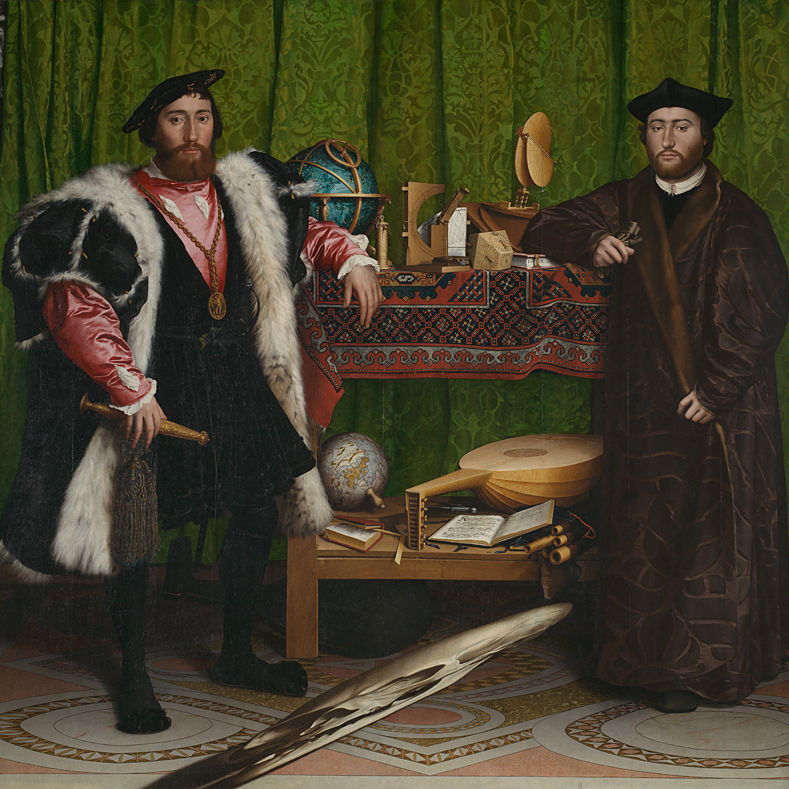Picasso held that there were no bad Picassos; some were merely more or less good than others. I feel the same about Hans Holbein and, after reading The King’s Painter, Franny Moyle’s “life and times” of the artist, suspect he did, too.
His life necessarily gets shorter shrift than the times. Moyle concedes, “Anyone taking on Holbein as a subject has to deal with the fact that primary written material relating to the artist is sparse, to say the least.... His earliest biographer, Carel van Mander, scooped up as much anecdote as he could. But if Holbein ever put pen to paper other than to draw—and surely he did—his correspondence has long been lost.”
He died nearly 500 years ago. More than that, he lived in an era of whirligig religious and political events and, at the height of his career, served at the pleasure of the granddaddy of lecherous, homicidal caprice, Henry VIII of England. Holbein, whose gift for self-preservation was highly developed, can be forgiven for not leaving behind anything in writing on even the most trifling subject.
Origin Story
He was born in Augsburg, Germany, around 1497—the year of Savonarola’s Florentine bonfire of the vanities—and learned the power of patronage and devotional art from his father, Hans Holbein the Elder (Hanns Holbain in those days). In Holbein Sr.’s depictions of the juvenile Hans—including the Walther Memorial (1502)—Moyle perceives “vital clues” about the childhood of an artist “whose talents were evident early on, and who was marked out for greatness from the off.”
Poor Ambrosius, Hans’s older brother; little Hans is, indeed, the “focus of attention and affection” in the apparent likenesses Moyle cites. “Could such intentional signalling reflect the fact that even before he had reached double figures, Hans Holbein the Younger was already exhibiting a prodigious talent that boded well for future patronage?” Maybe. Or, equally, Holbein Sr. may simply have been partial to his youngest.
Whatever the case, Hans (along with Ambrosius) followed in his father’s journeyman footsteps, landing in Basel in 1515. There he met Desiderius Erasmus, the brilliant scholar and theologian who would become an instrumental friend and frequent sitter. Holbein illustrated an edition of Erasmus’s wildly popular satire, In Praise of Folly (1511), and painted the sage at least eight times by Moyle’s reckoning. Critically, Erasmus smoothed the way for Holbein’s move to London, in 1526.

The prior decade in Basel had seen his marriage to the widowed Elsbeth Schmidt, several important commissions, Luther’s Ninety-Five Theses (1517), continental wars, the recurrence of plague, and, relatedly, financial troubles. Erasmus’s first introduction for Holbein in England was to Henry’s adviser on the Royal Council, Thomas More, whose Utopia had been published 10 years before.
More’s praise was effusive and immediate: “Your painter friend, my dear Erasmus, is a wonderful artist.” As was his assistance: “I fear he will not find England the rich and fertile land he hoped … however, lest he find it quite barren, I shall do what I can.”
Moyle covers this strange, bloody period well, though nothing can quite match Hilary Mantel’s trio of “Wolf Hall” novels. More, Thomas Cromwell, and anyone unlucky enough to have shared Henry’s bed lost their head on the scaffold. It was Holbein’s remarkable, hazardous fortune to memorialize Henry and his principal victims.
At the height of his career, Hans Holbein served at the pleasure of the granddaddy of lecherous, homicidal caprice, Henry VIII of England.
Whether portraying would-be consorts for Henry, family members, merchants, or martyrs past—his Body of the Dead Christ in the Tomb (1521–22) “mesmerized” Dostoyevsky and featured in The Idiot (1869): “Some people may lose their faith by looking at that picture”—and present, Holbein never failed to capture his subject’s inner essence.
Growing up, I felt that I knew Thomas More, less from his books and beliefs than from his eloquent portrait at the Frick. (It is, incidentally, the spitting image of Laurence Olivier.)
The pictures of Henry belong in their own category for their splendor—and splendid equivocation. “Designed so cleverly to speak to Henry and his followers,” observes Moyle, “[they] can also offer the modern viewer not so much a depiction of magnificence but of bloated self-indulgence.” The beady eyes; the thin, puckered lips; the flattened, neckless head—to know Holbein’s Henry was, to the biased modern eye, to loathe him.
Holbein was reputed to be the “most ‘cunning’ painter of his day” (if this makes you think of Blackadder’s sidekick, Baldrick, you’re not alone): “On the one hand this is a term that alluded to his ability as an illusionist,” Moyle notes, “whose grasp of mathematical perspective was so formidable, and whose observation and draftsmanship so exceptional, he could create persuasive, lifelike work. But the term also refers to the intellectual conceits he conjured to delight his viewers”—above all, to Holbein’s incomparable masterpiece, The Ambassadors (1533).
The King’s Painter is satisfying on this “most famous, mysterious, contested and beguiling painting,” even if Moyle doesn’t bother with Stephen Greenblatt’s Renaissance Self-Fashioning (1980)—The Ambassadors was Greenblatt’s cover image and among his signature examples—and its assertions of identity. The titular French diplomats, Jean de Dinteville and Georges de Selve, are set off by the luxurious green damask curtain running the length of the panel, and by the globe, lute, and books, indicating wealth and worldliness. The pair is so thoroughly upstaged, however, by the anamorphic sliver in the foreground, designed to be viewed from the extreme right-hand side: “Only [then] … does the ovoid brown sludge snap into proper perspective and reveal itself as hard dead bone in the form of a human skull.”
Surviving Henry’s brutal whim was one thing; outlasting the Black Death, another. In May 1543, it struck London again, curtailing Holbein’s opportunities at court. A July proclamation prohibited “entering the gates of any house wherein the King or Queen lie, and forbidding servants of the Court to go to London and return to Court again.” Holbein had occasion to draw up his will in October; it was executed in November. The creator of the unsettling Body of the Dead Christ in the Tomb and Dance of Death sequence of woodcuts (1523–25) was buried, if he was buried at all, in an unrecorded grave.
Max Carter is the head of the Impressionist and Modern Art department at Christie’s in New York


